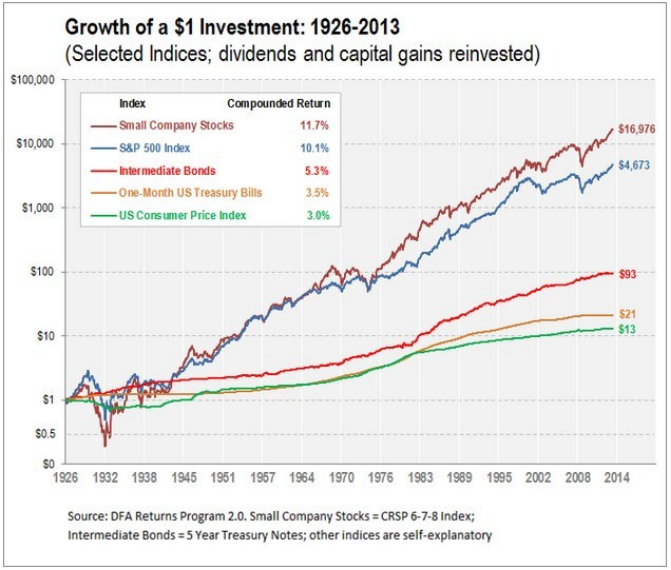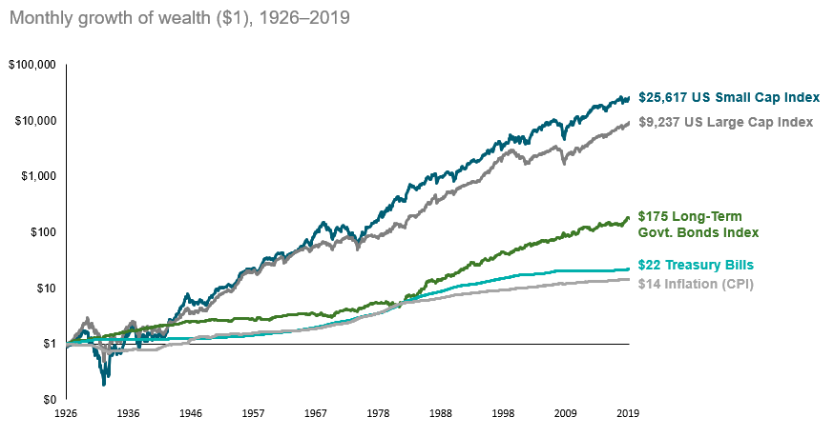9장: 투자 기본
수업 학습 목표:
- Sources of Investment Income:
- Understand the primary sources of income from investments, including interest, dividends, and capital gains.
- Understand the primary sources of income from investments, including interest, dividends, and capital gains.
- Types of Investments:
- Learn about different investment options such as stocks, bonds, mutual funds, index funds, ETFs, real estate, and commodities.
- Learn about different investment options such as stocks, bonds, mutual funds, index funds, ETFs, real estate, and commodities.
- Investment Risk and Return:
- Grasp the relationship between risk and return, the importance of diversification, and how to compare investment performance to market benchmarks.
Understanding Income from Investments
- Interest: Money earned from deposit accounts or bonds. Interest is paid at a predetermined rate for the use of the funds deposited or loaned.
- Consider a bond that pays 5% annual interest on a $10,000 investment, yielding $500 in interest income per year.
- Dividends: Payments made to shareholders out of a corporation’s earnings. Dividends provide a return to shareholders for their investment in the company’s equity.
- If you own 100 shares of a company that pays an annual dividend of $1 per share, you receive $100 yearly.
- Capital Gains: The profit realized when an investment is sold for more than its purchase price. Capital gains are a form of income from the increase in value of the investment over time.
- Buying a stock at $100 and selling at $150 results in a $50 capital gain per share.

그림 제목: $1 투자의 성장: 1926-2013
원천: 그래니트 힐 캐피탈
설명: 차트는 1926년부터 2013년까지 다양한 투자 지수에 걸쳐 $1 투자의 성장을 배당금과 자본 이득 재투자와 함께 보여줍니다. 지수에는 중소기업 주식, S&P 500 지수, 중간 채권, 1개월 미국 국채 및 미국 소비자 물가 지수가 포함됩니다. 이 차트는 2013년 말까지 거의 $17,000까지 성장하여 다른 지수를 능가하는 소규모 회사 주식의 탁월한 성장을 강조합니다.
주요 내용:
- 중소기업 주식의 우월한 성장: 1926년 소규모 회사 주식에 대한 $1 투자는 2013년 말까지 거의 $17,000으로 증가했습니다.
- S&P 500 지수: 소규모 회사 주식만큼 뚜렷하지는 않지만 수년에 걸쳐 일관된 성장을 보여줍니다.
- 중간 채권 및 재무부 채권: 주식에 비해 꾸준하지만 완만한 성장을 제공합니다.
- 미국 소비자 물가 지수: 인플레이션의 척도로 사용되며 시간이 지남에 따라 1달러의 구매력이 감소하는 것을 보여줍니다.
애플리케이션: 이 차트는 주기적인 시장 침체에도 불구하고 주식, 특히 소규모 회사 주식의 장기적인 성장 잠재력을 강조합니다. 그러나 다양한 자산 클래스가 다양한 위험 수익 프로필을 제공하므로 다각화의 중요성도 강조됩니다. 투자자의 경우 역사적 성장 패턴을 이해하면 할당 결정을 내릴 때 맥락을 제공할 수 있으며, 성장 잠재력과 위험 허용 범위를 모두 고려하는 균형 잡힌 포트폴리오의 중요성을 강조할 수 있습니다.

그림 제목: $1의 장기 성장: 주식 vs 채권 vs 인플레이션
원천: 대로우 웰스 매니지먼트
설명: 차트는 장기간에 걸쳐 $1 투자의 성장 궤적을 표시하고 주식, 채권 및 인플레이션의 성과를 비교합니다. 차트는 장기적으로 채권과 인플레이션을 능가하는 주식의 실질적인 성장 잠재력을 강조합니다.
주요 내용:
- 주식은 장기적으로 우수한 성과를 냅니다: 장기간에 걸쳐 주식은 역사적으로 채권보다 더 높은 수익률을 제공했으며 인플레이션을 능가했습니다.
- 채권은 안정성을 제공합니다: While bonds may not offer the same growth potential as stocks, they provide stability and income, especially during volatile market conditions
- 인플레이션의 침식 효과: 이 차트는 인플레이션으로 인해 시간이 지남에 따라 달러의 구매력이 감소하는 것을 강조합니다.
다각화가 핵심입니다: 주식과 채권으로 구성된 균형 잡힌 포트폴리오는 위험을 완화하고 원하는 재정적 결과를 달성하는 데 도움이 될 수 있습니다.
애플리케이션: 이 차트는 투자 포트폴리오의 다양화가 중요하다는 증거입니다. 주식은 성장 잠재력을 제공하지만 변동성은 더 높습니다. 반면 채권은 안정성을 제공하고 시장 침체기 동안 완충 역할을 할 수 있습니다. 투자자의 경우 이러한 자산 클래스의 과거 성과를 이해하면 할당 결정을 내릴 수 있으며 위험 허용 범위 및 재무 목표에 맞는 혼합을 보장할 수 있습니다.
Types of Investments and Their Purpose

수치: 인포그래픽은 투자 포트폴리오에 일반적으로 포함되는 "5가지 유형의 자산 클래스"를 간략하게 설명합니다. 이것들은:
- 자산: 여기에는 주식, 인덱스 펀드, 상장지수펀드(ETF) 및 뮤추얼 펀드가 포함됩니다.
- 채권: 이는 정부나 회사에 대한 대출을 나타냅니다.
- 상품: 예로는 금, 원유, 옥수수, 소, 은 등이 있습니다.
- 부동산: 주택, 아파트, 부동산 투자 신탁(REIT) 또는 토지가 될 수 있습니다.
- 현금: 은행계좌에 있는 돈이나 실물지폐를 말합니다.
인포그래픽은 투자할 수 있는 다양한 유형의 자산을 이해하려는 개인을 위한 교육 도구 역할을 합니다. 실제 사용을 위해 투자자는 투자 목표에 따라 위험과 수익 가능성을 분산시키기 위해 이러한 자산 클래스에 걸쳐 포트폴리오를 다양화하는 것을 고려해야 합니다. 그리고 위험 허용.
출처: 맞춤형 인포그래픽
Stocks: Equity investments that offer ownership in a corporation. Stocks have the potential for high returns but come with higher risk. For example, buying shares in Apple Inc. gives you a fractional ownership stake.

Figure: Illustration of a bull symbolizing a rising stock market, indicating a Bull Market Signal for global trading.
원천: 셔터스톡
- Bonds:

Figure: A visual concept of bonds investment, highlighting corporate bonds within the banking and finance market.
원천: 셔터스톡
Debt investments where the investor loans money to an entity (corporate or governmental) that borrows the funds for a defined period at a variable or fixed interest rate. Bonds are generally considered safer than stocks but offer lower potential returns. A U.S. Treasury bond is a loan to the government expected to be repaid with interest.
- Mutual Funds:

Figure: An investment consultant in a formal suit presenting a fund performance report with graphs on a laptop screen.
원천: 셔터스톡
Investment programs funded by shareholders that trade in diversified holdings and are professionally managed. Investing in a Vanguard mutual fund diversifies your risk across numerous stocks or bonds.
- Index Funds: Type of mutual fund with a portfolio constructed to match or track the components of a market index, offering broad market exposure with low operating expenses.
- Exchange-Traded Funds (ETFs):

Figure: A visual representation of an ETF (Exchange Traded Fund) in the stock market, symbolizing investment and financial concepts.
원천: 셔터스톡
Similar to mutual funds but traded on stock exchanges like individual stocks, such as the SPDR S&P 500 ETF They offer liquidity and low costs.
- Real Estate:

Figure: A conceptual photo of a house model on a balanced scale, symbolizing the equilibrium in real estate decisions.
원천: 셔터스톡
Investing in property, either directly by purchasing real estate or indirectly through Real Estate Investment Trusts (REITs).
- Money Markets and Annuities: Money markets provide a safe place for short-term investment. Annuities are financial products that offer a guaranteed income stream.
Tax Implications and Expenses
Investments are subject to different tax rates, affecting their after-tax returns. Understanding the tax treatment of interest, dividends, and capital gains is essential for evaluating the true cost of credit and the actual return on investments.
The expenses of buying, selling, and holding financial assets, such as management fees, commissions, and expense ratios, directly impact the investment’s rate of return.
Stocks, Bonds, Mutual Funds, Index Funds, and ETFs: The income from these investments can be taxed in various ways. Dividends from stocks and mutual funds may qualify for lower tax rates, while interest from bonds is usually taxed as ordinary income. Capital gains from selling these investments are taxed either as short-term (ordinary income rates) if held for less than a year, or as long-term (reduced rates) if held longer.
Stocks: Capital gains tax applies if stocks are sold at a profit, with rates depending on the holding period.
Bonds: Interest income is taxed at ordinary income rates.
뮤추얼 펀드: Taxes apply on both dividends received and capital gains distributions.
부동산: Income from rental properties is taxed as ordinary income, but investors can deduct expenses and depreciation. Selling real estate can result in capital gains tax.
Money Markets and Annuities: Interest from money market accounts is taxed as ordinary income. Annuities offer tax-deferred growth, but withdrawals are taxed as ordinary income, and premature withdrawals may incur additional penalties.
필수품: Profits from selling commodities, like gold or oil, are taxed as capital gains. Special rules, like those for collectibles, may apply, leading to potentially higher tax rates.
Investment Risk and Return
- The relationship between risk and return is fundamental to investing. Generally, higher-risk investments offer the potential for higher returns, while lower-risk investments offer more modest returns.
- A “blue-chip” stock, being from a large, well-established company, generally offers lower risk and return compared to a speculative Internet start-up company, which might offer high returns but also carries a high risk of loss.
- Investing in a “blue chip” stock like Johnson & Johnson might offer more stable returns and lower risk compared to a volatile internet start-up, reflecting the trade-off between risk and potential return.
- Investing in a “blue chip” stock like Johnson & Johnson might offer more stable returns and lower risk compared to a volatile internet start-up, reflecting the trade-off between risk and potential return.
- 다각화 across different types of financial assets can reduce investment risk, ensuring that a portfolio isn’t overly dependent on the performance of a single investment.
- Owning businesses in both the suntan lotion and umbrella markets, for example, can provide stability regardless of the weather, unlike owning two suntan lotion businesses, which would suffer in poor beach weather.
- An investor owning businesses in complementary seasonal industries (e.g., a ski resort and a beach resort) diversifies revenue sources, reducing overall business risk compared to owning two ski resorts.
Benchmarking Investment Performance
Comparing to a Benchmark:
Investors frequently benchmark the performance of their portfolios against established market indices, such as the S&P 500, to gauge their investment strategies’ effectiveness. For instance, an investor with a portfolio primarily consisting of large-cap stocks might use the S&P 500 as a benchmark to assess whether their investment choices are outperforming, matching, or underperforming the broader market’s performance.
Understanding Benchmark Indices:
Popular benchmark indices include the S&P 500 (large-cap stocks), the Dow Jones Industrial Average (30 significant U.S. companies), and the NASDAQ Composite (tech-heavy index). By comparing these indices’ performance, investors can understand various market segments’ trends. For example, if the NASDAQ Composite performs significantly better than the S&P 500 in a given year, it may indicate a strong performance in the technology sector.
Advantages of ETFs Tracking Market Indices:
Exchange-Traded Funds (ETFs) that track market indices offer several advantages over actively managed mutual funds or individual stock and bond investments. Firstly, they provide diversification, reducing the risk associated with investing in single stocks or sectors. For example, an ETF tracking the S&P 500 provides exposure to 500 different companies across various industries. Secondly, ETFs generally have lower expense ratios than actively managed funds, making them a cost-effective option for investors. Finally, ETFs offer liquidity and flexibility, as they can be bought and sold like stocks throughout the trading day.
Practical Example:
Consider an investor evaluating between an actively managed mutual fund with a 1% annual fee and an S&P 500 index ETF with a 0.03% fee. Over 20 years, the difference in fees can significantly impact the net return, especially if the mutual fund fails to consistently outperform the S&P 500 index. Additionally, the ETF provides broad market exposure, mitigating the risk of underperformance due to poor stock selection or sector downturns in the actively managed fund.
Short-term vs. Long-term Investments
Shorter-term investments, like savings accounts or short-term bonds, generally offer lower rates of return compared to longer-term investments like stocks or long-term bonds. This reflects the greater uncertainty and potential for growth over longer periods.
Influence of Economic Factors on Investment Prices
Interest rates, economic conditions, and government policies can all impact the value of financial assets. For instance, an increase in interest rates often leads to a decrease in the current value of bonds.
The government provides critical oversight to ensure fair and transparent markets and protect investors. For example, accurate information about a company’s financial health is essential for making informed investment decisions.
An interest rate hike can decrease the market value of existing bonds as new bonds issue at higher rates, making the old bonds less attractive in comparison.
Modern Financial Technology in Investing
- The rise of digital currencies, robo-advising, and discount brokerage firms facilitated by financial technology has democratized access to financial markets, offering new ways to invest but also presenting unique challenges and risks.
Investment Accounts
Retirement accounts (401(k), IRA), education savings accounts (529 plans), and taxable investment accounts each serve specific investment goals, offering various tax advantages and implications.
- 퇴직 계좌 (e.g., 401(k), IRA) offer tax advantages to encourage saving for retirement. 401(k) and IRAs: Facilitate retirement savings with tax advantages. A Roth IRA, for instance, offers tax-free growth and withdrawals.
- Education Accounts (e.g., 529 plans) provide tax-free growth for educational expenses. 529 Plans: Savings plans for future education expenses, offering tax benefits.
- Taxable Accounts offer flexibility but lack specific tax advantages. Each account type has its own set of rules, benefits, and limitations, influencing investment choices.
Decision-Making in Investing
- Investors’ risk tolerance, influenced by personal factors and life circumstances, guides their investment choices and strategies. Understanding one’s investment profile is crucial for building a portfolio aligned with individual goals and risk tolerance.
- The government’s role includes ensuring transparency and fairness in financial markets, enabling investors to make informed decisions based on accurate company data.
- A retiree might prioritize stability and income, favoring bonds or dividend-paying stocks, whereas a young, single person might pursue growth through higher-risk investments.
Managing Investment Expenses and Understanding Returns
- Awareness of the costs associated with investments, such as fees and taxes, and their impact on returns, is vital for effective investment management.
- The costs of managing investments, such as management fees for mutual funds (expense ratios), commissions for buying/selling stocks, and operational costs, all decrease the net return to the investor.
- For example, a mutual fund with a 1% expense ratio will reduce your investment’s return by 1% annually, which can compound significantly over time, reducing the total accumulated amount. Buying a mutual fund with a 1% expense ratio means you pay $10 annually for every $1,000 invested, directly reducing your return. If the fund’s market performance yields a 7% return, the actual return to the investor is 6% after expenses.
Market Dynamics and Investment Pricing
The prices of financial assets in markets are set by the collective actions of buyers and sellers. An increase in perceived risk for a bond, for example, will likely cause its price to drop as buyers demand a higher yield for assuming greater risk, affecting both the seller’s proceeds and the buyer’s future returns.
Financial Literacy and Professional Advice
- Navigating the complexities of investing often requires professional advice. Selecting the right financial advisor involves considering factors like expertise, experience, fees, and investment philosophy.
- When choosing a financial advisor, consider their credentials (CFP®, CFA), experience, fee structure, and investment philosophy. Transparent communication about fees and investment strategies is crucial.
The Importance of Being Informed
- Being an informed investor involves continuous learning and staying updated on market conditions, regulatory changes, and new investment opportunities. This proactive approach helps in making informed decisions that align with long-term financial goals.
Digital Currency as an Investment

그림: 디지털 통화의 다양한 환경을 대표하는 다양한 알트코인 토큰과 함께 비트코인(BTC) 암호화폐 코인의 클로즈업 사진.
원천: 셔터스톡
Digital currencies, like Bitcoin, are volatile investments affected by market demand. They offer opportunities for speculation, privacy in transactions, and international payments without traditional banking fees, but they also carry significant risk due to their volatility and regulatory uncertainties.
Investment Strategies and Principles
- Developing a long-term investment strategy can leverage the power of compound interest, significantly impacting wealth accumulation over time.
- Diversifying investments across asset classes (stocks, bonds, real estate) reduces risk and can lead to more stable returns.
By understanding these fundamental aspects of investing, including the mechanisms of returns, regulatory frameworks, and strategic considerations like risk tolerance and diversification, investors are better equipped to make informed decisions that align with their financial goals and risk appetite.
주요 수업 정보:
- Income from Investments:
- Interest, dividends, and capital gains are the main sources of investment income, each with different risk and return profiles.
- Interest, dividends, and capital gains are the main sources of investment income, each with different risk and return profiles.
- Types of Investments:
- Stocks offer high potential returns with higher risk, bonds provide more stability with lower returns, and mutual funds, index funds, and ETFs offer diversified investment options.
- Real estate and commodities present additional investment opportunities with their own unique risks and returns.
- Risk and Return:
- Higher-risk investments generally offer higher potential returns, while lower-risk investments provide more stable returns.
- Diversification across different types of investments can reduce overall portfolio risk.
- Comparing your investments to benchmark indices like the S&P 500 helps gauge their performance.

